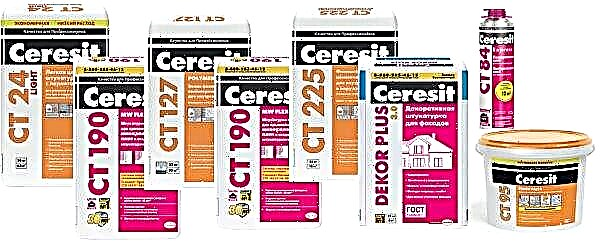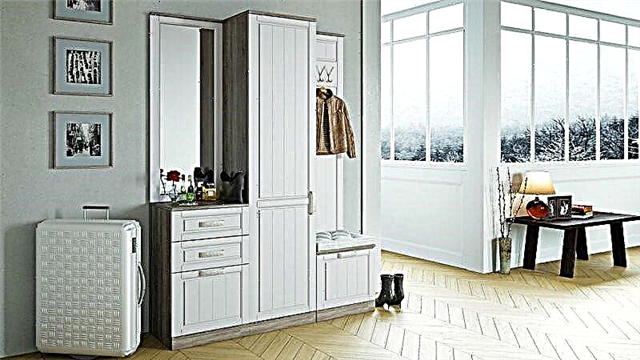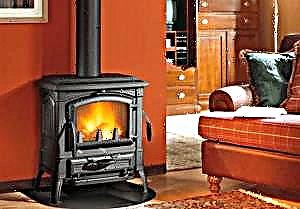 Wood-burning stoves are durable and popular designs, characterized by high performance, easy installation.
Wood-burning stoves are durable and popular designs, characterized by high performance, easy installation.
They are able to heat any area in suburban, private homes.
The stoves retain heat for 12 hours, without requiring constant refueling of firewood.
They also have an attractive appearance, because the body resembles a real expensive fireplace.
The article provides an overview of popular models of wood-burning stoves, based on consumer reviews.
How to choose and what to pay attention to?
The following tips:
- Type of construction - it can be built-in or wall-mounted. The first saves space by being in the wall. But it requires preliminary creation of the project. The second can be mounted anytime, anywhere. Requires the installation of a chimney. It is the most popular.
- Consider housing material. Stoves are made of cast iron, brick and steel. Which model to choose - the consumer decides for himself. Materials have proven themselves only on the positive side - they are not susceptible to corrosion, durable, durable, evenly give off heat.
- Efficiency. The higher the indicator, the faster the room heats up, the longer the heat is maintained. The best option for small houses is a stove with an efficiency of 75% and higher, for large areas - from 85%.
- Estimate the diameter of the chimney. The wider the hole, the more efficient the removal of combustion products. The best option is considered stoves with a chimney diameter of 14 cm.

Rating TOP 10 best models
| A place | Name | Price |
|---|---|---|
| TOP 10 best wood-burning fireplaces | ||
| 1 | Guca lava | Get a price |
| 2 | Kratki Koza K9 | Get a price |
| 3 | La nordica nicoletta | Get a price |
| 4 | La Nordica Ghisa Isotta Con Cerchi | Get a price |
| 5 | Brandenburg Brandenburg with cast iron stove | Get a price |
| 6 | Invicta chamane | Get a price |
| 7 | EcoCamin Bavaria | Get a price |
| 8 | Guca mercury | Get a price |
| 9 | Teplodar Vertical Ceramics | Get a price |
| 10 | THORMA Milano II | Get a price |
Guca lava
Closed-type floor fireplace stove allows to heat residential private and country houses. Heat begins to flow in  rooms in 15-20 minutes, and the long-term burning system supports it for 8 hours from one bookmark of firewood.
rooms in 15-20 minutes, and the long-term burning system supports it for 8 hours from one bookmark of firewood.
Equipped with a cast iron hob of an unusual shape, with the possibility of placing 2 containers on it.
The model has gained popularity thanks to the cast-iron case, which excellently accumulates heat and evenly distributes it throughout the room.
Specifications:
- heating volume - 240 m3,
- power - 12 kW,
- there is a chimney with a diameter of 12 cm, top connection,
- Efficiency - 78.1%
- type of fuel - firewood,
- there is a box for ash,
- case, firebox and top panel material - cast iron, doors - glass,
- dimensions - 54x94.6x49.3 cm,
- weight - 155 kg.
Advantages:
- large sizes of facade glass,
- clear glass system
- "long burning" system
- system of "secondary afterburning of carbon monoxide" to increase efficiency,
- economical consumption of firewood,
- Attractive appearance
- suitable for installation anywhere in the room,
- strong and durable case.
disadvantages:
- unfinished ash pan design,
- uncomfortable pens.
Kratki Koza K9
This is a floor-standing cast iron fireplace stove for a summer house and a country house. The wall thickness is 8 mm, cast from  gray cast iron. They allow you to evenly distribute heat throughout the room.
gray cast iron. They allow you to evenly distribute heat throughout the room.
Adjusting the combustion air supply reduces the time of burning wood.
Not only firewood, but also coal briquettes are used as fuel.
It has a unique appearance - each structural element is cast iron, has a complex "carved" shape.
The stove will fit perfectly into any interior of the room, and the panoramic door will open a wonderful view of the game of fire.
Specifications:
- heating volume - 250 m3,
- power - 13 kW,
- there is a chimney with a diameter of 15 cm, rear and top connection,
- Efficiency - 78%,
- fuel type - firewood (min. length - 35 cm), coal briquettes,
- there is a box for ash,
- case material - cast iron, doors - glass,
- dimensions - 76.6x66x54.6 cm
- weight - 160 kg.
Advantages:
- quick heating of the area,
- not demanding on the type and quality of firewood,
- capacious fire chamber,
- the door consists of triple glass,
- clear glass system
- efficient removal of combustion products,
- environmental friendliness, safety of use.
disadvantages:
- fast blackening of glass
- smoke transmission is observed
- the chimney is quickly clogged.
La nordica nicoletta
It is a reliable and convenient heating device.. The uniqueness lies in the exquisite Italian design - the body of the stove 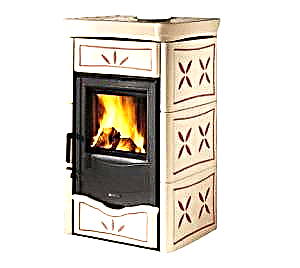 may be burgundy, beige or cream.
may be burgundy, beige or cream.
The sophisticated airflow system is designed to use a fireplace in smoldering mode, long burning.
The floor design acts as an independent heating equipment, works perfectly together with central heating.
The wide chimney is easy to clean, quickly removes combustion products from the room.
Specifications:
- heating volume - 229 m3,
- power - 8 kW,
- there is a chimney with a diameter of 13 cm, top connection,
- Efficiency - 80.9%,
- type of fuel - firewood,
- case material - cast iron, doors - glass,
- dimensions - 58.7x98x57.2 cm,
- weight - 168 kg.
Advantages:
- quick warming up of rooms,
- long heat preservation,
- there is a compartment for storing firewood,
- stylish design,
- safety of use,
- high quality device performance and practicality,
- the glass remains clean after several ignitions,
- ceramic cladding excludes injuries to adults and children.
disadvantages:
La Nordica Ghisa Isotta Con Cerchi
Floor heating model. It can function with central heating. Double cast iron 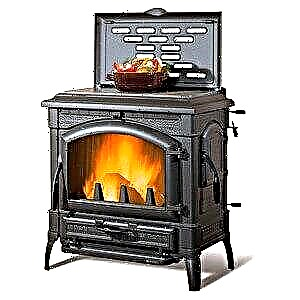 the walls protect against burning of the case, which affects the durability of the stove.
the walls protect against burning of the case, which affects the durability of the stove.
The peculiarity is the presence of a full cooking surface, complemented by a protective cover.
Uniqueness - the presence of a side door for loading firewood, an easy ignition function, summer operation (plays the role of a tile for cooking).
Specifications:
- heating volume - 338 m3,
- power - 11.9 kW,
- there is a chimney with a diameter of 15 cm, rear connection,
- Efficiency - 82%,
- fuel type firewood with a maximum length of 30 cm,
- the volume of the furnace is 62.3 l,
- functions - flame adjustment, clean glass, long burning, secondary afterburning,
- equipped with an ash box, hob,
- case and firebox material - cast iron, doors - glass,
- dimensions - 79x83x66 cm,
- weight - 216 kg.
Advantages:
- top quality cast iron,
- large-sized door with a panoramic view,
- handle for contactless grate cleaning,
- convenient fuel loading,
- sealed firebox
- functionality,
- environmental friendliness
- economical consumption of firewood.
disadvantages:
- instant glass contamination on slow burning,
- cools quickly after burning wood.
Brandenburg Brandenburg with cast iron stove
This is a floor stove made of cast iron, steel and ceramics.. The combination of materials allowed to obtain  high-performance model that gives off heat 15 minutes after laying firewood.
high-performance model that gives off heat 15 minutes after laying firewood.
For the manufacture of doors used direct glazing technology, which is used only in Germany and Japan.
The oven is ideal for cooking, since the cast iron hob is heated to +200 degrees.
Specifications:
- heating volume - 120 m3,
- power - 9 kW,
- there is a chimney with a diameter of 11.5 cm, rear connection,
- type of fuel - firewood,
- functions - secondary afterburning, clean glass, long burning,
- case material - steel, doors - glass, cladding - ceramics,
- dimensions - 56x84x46 cm,
- weight - 118 kg.
Advantages:
- plays the role of a full tile,
- the cladding is covered with chamotte,
- environmental friendliness
- safe operation
- has a fuel storage compartment,
- resistance to high temperatures.
disadvantages:
- small volume of the furnace
- cools quickly
- unfinished system of long burning.
Invicta chamane
French model with exquisite youth design. Made of cast iron, so it instantly warms up a large 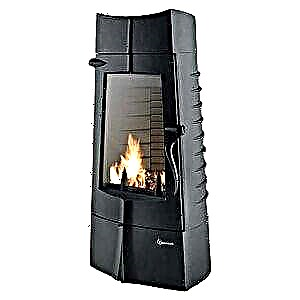 area and maintains heat for 10 hours.
area and maintains heat for 10 hours.
Acts as an independent heat source or can be paired with central heating.
The handle-lock in the form of a large comma hermetically locks the firebox, does not allow the fire to go beyond the camera, perfectly complements the designer's idea.
Specifications:
- heating volume - 190 m3,
- power - 14 kW,
- there is a chimney with a diameter of 18 cm, top connection,
- fuel type - firewood with a maximum length of 33 cm,
- Efficiency - 78.8%,
- functions - secondary afterburning, long burning - 10 hours, clean glass,
- it is completed with a box for ashes,
- case material - cast iron, doors - glass,
- dimensions - 57.8x120x56 cm,
- weight - 160 kg.
Advantages:
- large-sized panoramic glass,
- efficient and fast heating
- uniform heat distribution
- Great designer design
- easy installation of the chimney,
- high-quality removal of combustion products,
- environmental friendliness and safety of use.
disadvantages:
- cools quickly
- fly ash.
EcoCamin Bavaria
This product was developed according to the technologies of high European quality, but domestic  manufacturer. The stove is characterized by ease of installation, high power capabilities.
manufacturer. The stove is characterized by ease of installation, high power capabilities.
After installation, the owner receives a comfortable warmth and a wonderful panorama of a live fire.
The fireplace functions in continuous burning for up to 5 hours, acts as the main source of heat.
Equipped with a hob for cooking various dishes, heating the kettle.
Specifications:
- power - 9 kW,
- there is a chimney with a diameter of 15 cm, top connection,
- type of fuel - firewood,
- it is completed with an ash box, a fuel storage tank,
- construction material - cast iron, doors - glass,
- dimensions - 59x86x47.5 cm,
- weight - 126 kg.
Advantages:
- fast and uniform heating of the room,
- it doesn’t matter the quality and type of firewood,
- interesting design
- large panoramic glass
- sealed enclosure
- safe operation and environmental friendliness.
Disadvantages:
- glass gets dirty quickly
- the door has not been fully developed.
Guca mercury
Cast iron model with refractory glass door. The furnace is equipped with primary and secondary air regulators that regulate  the amount of air supplied for high-quality combustion.
the amount of air supplied for high-quality combustion.
In this case, the primary should be open at the time of ignition - 15-20 minutes.
When a stable combustion mode is reached, it closes. This allows you to achieve fuel economy, high-quality space heating.
A secondary regulator is necessary to keep the glass clean and improve the subsequent combustion process.
Specifications:
- heating volume - 250 m3,
- power - 13 kW,
- Efficiency - 82%,
- there is a chimney with a diameter of 12 cm, top and rear connections,
- functions - clean glass,
- equipped with a hob,
- dimensions - 57.8x53.5x39 cm,
- weight - 110 kg.
Advantages:
- the ability to set the long burning mode,
- the hob does a great job of cooking,
- uniform heating of rooms,
- big glass
- beautiful appearance
- not whimsical to the type and quality of firewood,
- environmental friendliness, safe operation.
disadvantages:
- the door does not lock
- no ash box.
Teplodar Vertical Ceramics
Heating and cooking device for heating residential areas. With its compact size, it effectively heats 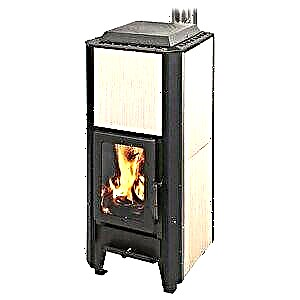 rooms, works in a long burning system.
rooms, works in a long burning system.
Maintains heat on one tab of firewood up to 8 hours.
It is equipped with special heat sinks to which ventilating corrugations are connected. They are suitable for heating adjacent rooms.
Decorative convector made of ceramic tile.
The material is easy to change for a better combination with the overall interior.
Specifications:
- heating volume - 120 m3,
- there is a chimney with a diameter of 11.5 cm, rear and top connection,
- functions - system of long burning, 8 hours,
- it is completed with an ash pan,
- case material - steel, furnaces - cast iron, doors - glass,
- dimensions - 37.5x88x42.5 cm,
- weight - 44 kg.
Advantages:
- full cast iron stove,
- effective two-turn chamber made of stainless steel,
- compact size and light weight,
- there are heat sinks on the back of the case,
- ceramic convector,
- fuel economy,
- environmental friendliness, safety.
Disadvantages:
- heat is observed only during the burning of firewood,
- declared burning time is not true.
THORMA Milano II
Attractive stove with high heating rates. Has gained popularity  multifunctionality, great design.
multifunctionality, great design.
Available in a wide color palette - black, beige, white, burgundy.
Each buyer can choose for himself an excellent solution, according to the general interior of the room.
Refractory triple glass eliminates the penetration of smoke into the room, opens a panoramic view of the game of fire.
Specifications:
- heating volume - 124 m3,
- power - 5 kW,
- Efficiency - 72%,
- there is a chimney with a diameter of 12 cm, rear connection,
- functions - secondary afterburning, flame adjustment, clean glass, long burning,
- equipped with an ash pan, hob,
- case material - steel,
- dimensions - 38x89x36 cm,
- weight - 72 kg.
Advantages:
- flue gas afterburning,
- you can use firewood up to 40 cm long,
- spacious ash pan
- there is a mechanism for ash discharge,
- two convection chambers,
- the hob is complemented by a cast iron lid,
- the cleanliness of the room.
Fireplace stove for a country house: savings and ease of use
The best way to heat an individual house is to install a long burning stove. For many years, this type of equipment is in demand in many countries of the world. It allows not only to maintain the optimum temperature in a living room for a comfortable stay, but also to complement the interior of the fireplace room or living room in an original way.
Among a wide variety of models, it is cast-iron wood-burning fireplaces that are considered an excellent alternative to central heating. They are also able to function on woodworking waste, which makes them even more profitable and economical. With the help of such equipment, it is possible to effectively heat a residential building, cottage or cottage. In addition, solid-fuel models can be found in the heat supply of garages, production halls, warehouses and garages.
Home fireplace and its advantages
A long burning wood-burning stove, regardless of model and manufacturer, is in great demand among domestic consumers. And not surprised, because she has many unique advantages:
- high efficiency - slow burning of fuel reduces its consumption,
- fast and efficient room heating,
- excellent heat resistance,
- safety of use in compliance with operating rules,
- ease of installation and scheduled maintenance,
- resistance to high temperatures,
- long service life.
Wood burning stove: accommodation options
There are several ways to install heating equipment for long burning in the house:
- Corner layout. A wood-burning fireplace stove is mounted diagonally with the possibility of a fan-mounted installation of upholstered furniture - armchairs or ottomans.
- Wall location. The most common installation option.However, it is worth considering the correct ratio of the dimensions of the stove to the area of the room: for a large living room or fireplace room, a large heating device will be ideal, respectively, for a small-sized room, it is better to choose a small stove.
- Embedding in a niche. A rather complicated and time-consuming method of installing a fireplace, so it is possible to implement it only at the initial stage of house planning.
- Central location. Fireplaces installed in the middle of the room look very unusual and original. Their installation will be advisable in spacious rooms with good insulation.
Steel or cast iron stove-fireplaces for the home: the rules of choice
To buy a fireplace stove in Moscow today is not difficult. However, before you go looking for the perfect heating equipment, you need to set priorities for yourself and carefully think about how you want to see this device.
The main parameters taken into account when choosing this heating equipment are:
- technical dimensions
- weight,
- price policy,
- design performance
- functionality
- security,
- durability.
Also on the domestic market are presented models of stoves, fireplaces, which differ in heated volume, fire chamber material, design features and power. Modern manufacturers of solid fuel equipment offer to buy devices of various types:
- with vertical bookmark,
- with horizontal tab
- direct action
- with secondary air flow (injection).
For a wood-burning stove for a house, the price may depend on the material of manufacture, functionality and external design. Today, you can buy heating equipment of this type, taking into account the chosen style of the interior of the room.
Separately, I want to note the heating and cooking cast-iron stove fireplaces for a home on wood. Such equipment makes it possible not only to efficiently heat the house, but also to cook food. Installations of this type are simply indispensable in a country house or cottage where there is no gas.
Where to buy a wood-burning stove for a house?
KaminDom online store is a well-known online portal specializing in the sale of heating equipment. The catalog includes wood-burning stoves for fireplaces from well-known manufacturers in a wide range.
Why should you buy a stove from us?
- certified product quality,
- Original design solutions
- excellent view of the fire
- high percentage of equipment efficiency,
- professional installation
- nice price offers
- fast delivery.
You can always clarify the purchase conditions by contacting our managers at the telephone number listed on the website. Also, we are always happy to see you in our store in Moscow. Our prices for steel and cast-iron stove-fireplaces are quite acceptable and worthy.
The principle of operation of the fireplace stove long burning
In detail analyzing the diagram of the fireplace and stove, we have repeatedly said that one of the main elements of the heating structure is a firebox, chimney and ash pan.
So, the peculiarity of long-burning furnaces lies precisely in the fact that there is no ash pan in it, through which cold air is drawn in.

Scheme of a long burning furnace
The ash pan performs the function of not only blowing, but also allows the fireplace to be systematically cleaned of ash and ash. Here, the principle of operation is such that there are practically no combustion products left.
And the oxygen that is directly involved in the combustion process of the stove is supplied to the wood-burning stove through a special hole. This is a kind of supply pipe, which allows you to regulate the flow of oxygen and, accordingly, affect the combustion rate of the furnace.

Long-life cast iron stove
The key point of a long burning fireplace stove is the need to provide enough oxygen. This will allow to maintain stable combustion of fuel in the chamber and ensure economical consumption of firewood.
The principle of operation of a long-burning fireplace wood-burning stove is similar to a pyrolysis unit, where the main heat is generated not from the combustion of firewood or coal, but from the gasification of solid fuel. And although in this article we consider structures heated by wood, the principle for all units of long burning will be similar.
The combustion process itself takes place in a confined space, from where wood gas is released through a special pipe. Then the heated gas goes to the second, where it is mixed with the secondary air pumped by the fan.
This provides a continuous process that occurs until the firewood is completely burned. In this case, the combustion temperature sometimes reaches 1200 degrees. In this case, the raw materials are consumed very slowly, as necessary, which significantly increases the efficiency of such a fireplace fireplace.
High efficiency (80-85%) of continuous burning stoves is also achieved due to the successful location of the heat exchanger, which is a water jacket.
The device helps to evenly warm the water circuit around the entire perimeter, increasing heat transfer. The temperature of the exhaust gases usually does not exceed 130-150 degrees. The heat released in the fireplace warms the heat carrier as efficiently as possible.

Given that smoldering is extremely slow, long burning fireplaces, unlike pyrolysis furnaces and boilers, are not so demanding on the quality and humidity of the fuel. Of course, productivity will also decrease with wet firewood (more than 30%), but it will not fall as much as in a pyrolysis boiler.
A lot of models work on the basis of loose wood substances (sawdust, wood chips), on peat briquettes or on the basis of wood pieces, slices. But these are more factory models. But do-it-yourself constructions are better heated with firewood.
The model of a long-burning furnace appeared on the market relatively recently. At the beginning of the 21st century, the company Stropuva, thanks to the engineer Edmuntas Stropaitis, found a solution to the problem of constantly adding fuel to the boiler.
It was he who first came up with the supply of oxygen from above, due to which it became possible to realize prolonged combustion. Today it is the most practical device for heating the cottage, the level of productivity of which reaches 70, and sometimes 100%.
Design feature
But not only high performance is an advantage of this design.
The whole point of long burning is that not all the laying of firewood burns out at the same time, as happens in a classical furnace, but only the top layer.

This becomes possible due to air intake from above, and not from below through an ash pan. Thus, the burning of fuel occurs gradually, in its upper layer. When this layer burns out, a new portion of oxygen is supplied through the regulator, and exactly as much as is necessary for the combustion of the upper layer. This provides such a burning duration and the possibility of control over the process.
The main point in the fireplace stove is the maintenance of prolonged combustion, during which the complete decay of the fuel cells occurs. As a result of this process, large volumes of hot gases are formed and a large amount of heat is stably released.
Secondary afterburning takes place in the second chamber (upper).
In the fuel chamber, where the firewood is laid, the primary combustion of fuel occurs. Hot smoke rises up through the nozzle and there it is already completely burned out. But for the stimulation of the secondary afterburning of firewood, the design also provides for the presence of pipes through which oxygen is supplied.
Today, two systems of long burning, implemented in such devices, are widely used. These are the Canadian Buleryan system and the Baltic Stropuva. At the same time, the Burelyan system is very popular in our country because of its small size and low price. But the Stropuv system is less common due to the high price and a large number of technical parameters.
Traditionally, the Burelian system (this technology will be used in the long-burning fireplace stove described by us) is a small furnace consisting of two chambers.
In the lower chamber, the main combustion of firewood occurs, resulting in the formation of wood gas. When heated, it rises up and enters the second chamber, which it finds above the first.

Scheme of a furnace with a cooking surface for long burning
Here the diffusion of hot gas with air and secondary combustion takes place.
Another difference from a traditional fireplace stove is the location of the furnace door. If usually it is attached from below, then here the design will be somewhat different.
The very time of burning suggests that the process will need a large amount of firewood, which should be somewhere.
For this purpose, the lower chamber (or firebox) should be large, and the door through which firewood is laid is high enough.

Features of a long burning furnace
In the fireplace stove, the ash pan plays an exclusively technical role and is designed to clean the furnace of ash residues, which remains very little after double combustion of fuel. Considering the fact that air enters through a special hole located in the upper part of the furnace, the ash pan door must be absolutely airtight.
Otherwise, there will be no talk of any prolonged burning if oxygen comes from the bottom of the furnace.
So, summarizing the design features of a long burning fireplace stove, the following points can be distinguished:
- a large volume of the furnace (boot) chamber,
- separation of the main firebox into two parts: the upper and lower chambers,
- lack of blowing
- adjustable oxygen supply from above.
The higher the humidity of the wood, the lower the efficiency of the stove. Therefore, it is recommended to use fuel with a moisture content of not more than 20% for combustion.
Advantages and disadvantages of a long burning fireplace stove
The design feature and the principle of operation of the continuous burning fireplace stove determine its following advantages:

Advantages of long burning furnaces
- High performance and efficiency.
- Autonomy of work. The fireplace stove can act as the main heating device.
- Fuel economy.
- Environmental friendliness of the heating process.
- Complete combustion of fuel, which means almost complete absence of ash.
- Quick heating of the room.
- Save time and resources.
- The convenience of use. A good long-burning fireplace stove can work 6-8 hours with one bookmark of firewood, without additional human intervention.
- High price compared to a conventional classic fireplace stove.
- Given the long combustion process and the large volume of the loading chamber, the chimney should be as high and straight as possible.
- In a homemade fireplace stove for long burning, the appearance is not particularly decorative.
This version of the fireplace stove is ideal for heating the house. But if the oven is necessary for cooking, heating water, you should look for other options.
Material classification
- Cast iron. One of the most popular models that are characterized by high performance and durability. The only drawback is their high weight and high price. One such oven will weigh at least 300 kg, so before installation, you should take care of a solid foundation and strengthen the floor.
Despite some differences in modification and style, the principle of operation of cast-iron stoves of long burning fireplaces is the same.
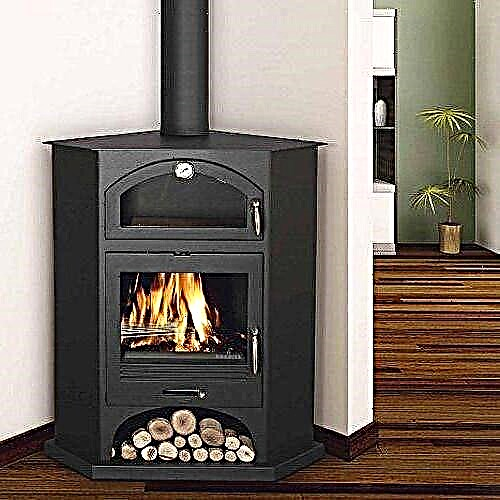
Some fireplaces are equipped with a glass door, which allows you to use the stove not only as a heating device, but also sit comfortably in front of it, admiring the flame.
On the market you can also find long-burning models equipped with a hob, which use the principle of convection heating method in their work.
Cast iron stoves long burning fireplaces, depending on the size of the loading chamber and modification, are able to work on one firewood tab for up to 10 hours without intervention.
But for this a prerequisite must be met. The moisture content of the wood laid in the furnace should be no more than 25%. Otherwise, the productivity of such a stove will drop sharply, and the wood will quickly burn through.
For self-made cast iron long-burning furnaces, use material with a thickness of 6 to 25 mm. Such a design is not suitable for heating a large room, since cast iron has low thermal conductivity.
The advantage of this design is resistance to long interruptions in work and resistance to corrosion. Paint, which over time may lose its appeal, is always easy to refresh.
When purchasing a cast iron stove with long burning wood with a hob, it is worth remembering that cast iron is a fairly fragile material. He is afraid of sudden changes in temperature, with sudden cooling, cracks may appear on it. Also, it is impossible to prevent the spill of cold water on a surface made of cast iron.
With proper care and proper operation, cast-iron stoves, long burning fireplaces can last for more than a dozen years, giving the owners of the cottage comfort and warmth.

Steel furnace long burning
- Steel. Unlike cast-iron units, they cool faster and, accordingly, are characterized by lower heat transfer. And in terms of durability, they are inferior to cast-iron counterparts.
- Ceramic. Such furnaces look very stylish and do not have a large mass, which allows not to perform a separate base under them. The only drawback is the high price and fragility of the structure.

If metal furnaces can easily be dismantled, transported and reinstalled without damage to integrity and without loss of operability, then it is difficult to do this with a ceramic furnace.
- Combined. Such designs are usually made of cast iron and steel.
Metal in its characteristics is not inferior to ceramic models. It lends itself perfectly to heat treatment, which allows you to perform a fireplace of any configuration. The indisputable advantage of metal fireplaces of long burning is their high productivity, which ranges from 85-90%.
If you make a furnace of the same construction of brick, then its maximum efficiency will be 65-70%. That is why sheet metal is used to make such stoves with their own hands.
The metal stove heats up quickly, which allows you to quickly warm up at home upon arrival at the cottage in the cold season.
For comparison, in a brick furnace of the same design, about 25% of the thermal energy will go into the atmosphere with smoke until it is completely warmed up and begins to transfer heat to the room.
Here, the metal immediately begins to give off heat.
Metal does not dampen during downtime, which is especially important for owners of summer cottages during the off-season period, when the owners go on the nature from time to time. Such a fireplace can be immediately kindled in a cold and cold house, without preliminary accelerating fire chambers.
Due to the lack of heat fluxes in a metal furnace, flue gases within a small space quickly burn out in it. Therefore, by embedding additional details in the form of a water circuit for heating water or heating a room, one can achieve much greater efficiency compared to a brick counterpart.
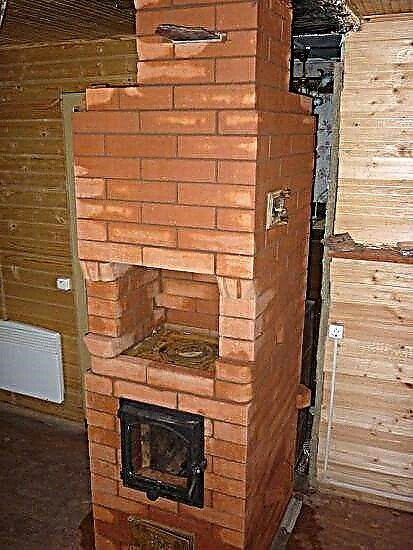
Brick continuous kiln
- Brick furnaces of long burning differ in a complex design and are laid out manually on a separately built foundation.The main technical characteristics and performance of such structures directly depends on the skill of the stove-maker.
Intended classification
- Heating stove fireplace long burning. The most popular and simplest option, implemented in metal, cast iron or brick. It has a sufficiently high efficiency (80-85%) and serves exclusively for heating the room. It features compact dimensions and is suitable even for cramped spaces. Usually, all models have a niche for firewood and a compartment for accumulations from ash.
- Heating and cooking. This option can be found in cast iron and steel.

Hob
The design allows you to warm water or even cook food, which will help reduce energy costs.
Also, fireplace stoves differ in the type of fuel use. There are combined models, which is the most practical solution, allowing you to heat the house with peat briquettes and firewood.
But in most cases, fireplace stoves were originally designed to burn a specific fuel.
Water circuit design
In a separate group of long-burning furnaces, a design with a water circuit can be distinguished. Such a fireplace stove has many advantages. By the principle of operation, this device resembles a solid fuel boiler.
High performance of such furnaces is achieved due to the successful location of the heat exchanger.
The design of the fireplace helps to evenly warm the water jacket around the perimeter. The temperature of the exhaust gas does not exceed 130-150 degrees. Due to this, the heat released in the furnace warms up the heat carrier as efficiently as possible.
Due to the complexity of the scheme and volumetric dimensions, stoves with a water circuit are mainly used for heating large rooms, large suburban mansions. For a small cottage or a one-story house, it is simply not economically rational to purchase such a fireplace.
Choose a long burning stove for giving
As mentioned above, today you can buy a finished cast-iron or steel structure of the stove - a long burning fireplace for a summer residence, which will not be difficult to install in the house.

Long burning wood stove
Let's dwell on the main selection criteria and consider the points that you should pay attention to when buying.
This is one of the key points on which the effectiveness of the device depends. Not all raw materials are intended for long burning. Firewood gives maximum performance with rapid combustion. But peat briquettes are able to give off heat for a long time, maintaining the desired temperature.
An important parameter that affects the duration of combustion and the efficiency of heat transfer. Today on the market are products made of steel, cast iron, and ceramics. For heating with wood, cast-iron structures are more suitable.
The choice of furnace material is largely dependent on the budget. Ceramic models cost a lot, but at the same time they do not surpass cast-iron or metal in characteristics.
- Furnace power. This parameter depends on the volume of the boot camera, so when choosing, pay attention to its size. The larger it is, the longer the boiler can burn with one load. This also ensures operating comfort, because then you do not have to toss new logs into the furnace every 2-3 hours.
- The weight of the structure.
This criterion is important during installation. A cast iron fireplace will be almost 20% heavier than steel. Therefore, if you do not need to strengthen the floor, it is better to give preference to a lighter steel stove.
- The price of the product. This, of course, is a very conditional parameter. But if you use the fireplace stove as the main source of heating, then you should not save.

A cast iron stove with a wood burning fireplace is the most optimal solution for heating a small house, representing something in between an expensive TT boiler and a conventional stove.
This design will effectively heat the house, spending a minimum of effort and raw materials. In addition, the modern model of such a fireplace will become a decorative highlight in the interior and will create an atmosphere of home comfort.
For proper and continuous operation, it must be cleaned of ash, not forgetting about the chimney.
Installing a long burning fireplace stove: step by step instructions
Following our detailed step-by-step instructions, you can easily install a fireplace stove for long burning. Although you can’t do without an assistant in this matter, because the weight of the device is at least 50 kg.
Prepare the following tools and materials:
- Locksmith set (adjustable, open-end wrenches, ring spanners).
- Building level.
- Saw with a disk.
- Metal shield.
- Screwdriver and a set of nozzles.
- Construction marker.
In addition to the furnace, it will be necessary to purchase materials for connecting to the chimney. The choice of material depends on which chimney you plan to make.
The optimal solution is a chimney made of sandwich pipes, which, depending on the location of the furnace, can be led out through the wall or roof.
Step 1. Determine the location of the fireplace stove
Immediately you need to take into account the place for the outlet of the chimney, the arrangement of the foundation (foundation) and, of course, the feasibility of placing a heating device in this zone.

We determine the place under the oven
The place for installation of the boiler should provide convenient operation and direct access
Stage 2. Fire protection of the room
- The base on which the fireplace will be placed should be covered with a metal shield. Consider the dimensions of the shield and furnace, which should be 15 cm smaller than the metal base on each side.
If the power of the fireplace exceeds 50 kW, then it must be installed on a foundation of concrete screed, which is separate from the main floor.

The basis for the furnace
If the fireplace power is less than 50 kW, then it is allowed to install the furnace on a rough concrete screed.
Before proceeding with the installation of the unit, be sure to check the level of the slope of the foundation with a building level.
It should be perfectly flat. If necessary (if the floor is not level), lay a foundation of brick. Check the level not only horizontally, but also diagonally.
- Mark with a marker on the floor the place where the oven will be installed. Observe the distance from the walls (regulated by SNiP). The distance between the firebox and the wall should be at least 125 cm. The distance between the side parts and the back of the fireplace and the wall should be at least 700 mm. You can act differently and lay a refractory sheet on the floor, on top of which ceramic tile is glued.

We spread the base with ceramic tiles

Wall to ceiling is protected with mineral wool (in sheets)
Stage 3. Installing a fireplace on the base
- Release the fireplace from the factory packaging and place it on the prepared base.
- Check with a building level how flat the appliance is. Make sure that the gas outlet pipe is flush with the chimney pipe.
- If the line is not straight, then traction during operation may be impaired.
Insert all necessary elements of the furnace provided by the design (ash pan, doors).
Stage 4. Connection to the chimney
If the furnace is installed in an operating house with a ready-made chimney system, it will be enough to connect the outgoing pipe of the furnace to the inlet of the chimney pipe.
To avoid smokiness of the room, it is necessary to carefully work out all the joints with sealant. If the stove is equipped in the house from scratch, then you must first assemble the gas exhaust system.

Chimney passage through a hole
Below we give a diagram of the assembly and connection of the furnace to the chimney from a sandwich pipe.

We remove the chimney through the ceiling
If you will use ordinary single-circuit steel pipes to assemble the chimney, then from the outside of the house, the chimney will need to be insulated.

Chimney with internal insulation
- Assemble the chimney from the pipes, carefully treating all joints with sealant.
- Keep in mind that the smaller the horizontal sections of the pipe, the better the traction and, consequently, greater efficiency. The area between the stove and the chimney must be at least 1 meter. Productivity and safety depend on this.
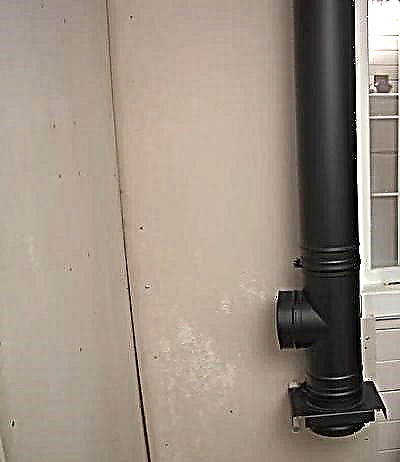
Fixing the chimney to the wall
Ideally, the chimney should have a minimum number of bends, because each additional turn creates an obstacle to the natural draft of gases, and reduces the productivity of the boiler.
It is also important to calculate that the joint of the chimney does not fall on the ceiling.
Try to tilt the horizontal section of the pipe at 45 degrees. If, for technical reasons, this cannot be achieved, then it is allowed to place the horizontal section at an angle of 15 to 30 degrees. In any case, it cannot be made even, otherwise it will interfere with normal traction.
- Connect the pipe to the first chimney pipe, which runs horizontally. The diameter of the chimney should not be less than the nozzle of the furnace. If these parameters are not met, then the throughput of the gas duct at maximum power will decrease.

Connect the pipe to the chimney

We fix the chimney on the roof

With proper installation and connection of the furnace, you will quickly appreciate its high productivity and cost-effectiveness of the design, which will allow you to maintain a comfortable microclimate in the house.
Homemade long burning stove made of metal
From the materials we need:

Elements of a homemade furnace
- A round barrel that will serve as the furnace body. Do not use an old barrel with traces of corrosion - such a furnace will not last long. The barrel must have thick walls to withstand high temperatures.
- Steel pipe.
- Building level and marker.
- Hammer.
- Hacksaw for metal.
- Mallet.
- Channel.
- Ax.
- Steel sheet.
- Welding machine.
The work process will be associated with a certain noise and dirt, so it is better to assemble such an oven on the street or in the garage.
- Determine the location of the homemade stove.

Preparing a body from a steel barrel
Given its low external qualities, it is better to use a non-residential area for this. If the cottage is equipped with only one room, then the stove can be placed in the corner, creating a small decorative screen that covers the structure. Take a metal barrel and use a marker to draw markings at the top, along which you will need to cut off the top. Immediately determine how much tank is needed for laying firewood. The more firewood you lay, the longer the stove will burn.
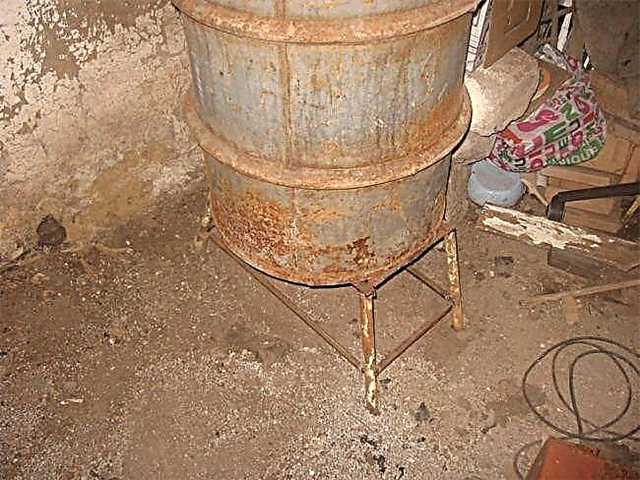
Remove the top and weld the legs
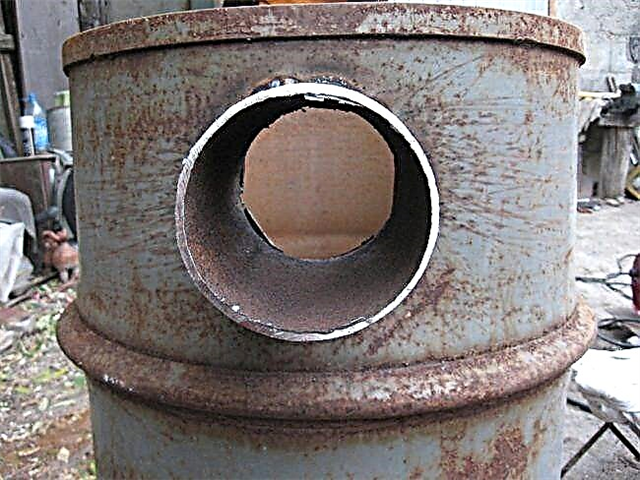
Preparing a hole for the pipe
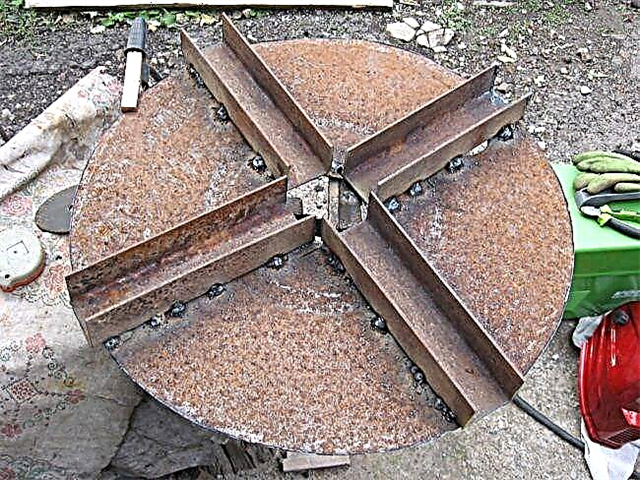
Only previously it is necessary to cut off the sidewall from it. Get a steel circle. With the help of a disk nozzle on the grinder, grind this circle from all sides - it should smoothly enter the inside of the barrel.

Weld the pipe to the steel circle

Making a furnace lid

Circle hole

The basis for the furnace
Given the light weight of the steel structure, there is no need to build a separate foundation for the furnace. It will be enough to lay out a base of brick, which is larger than the stove itself. We connect a homemade stove to the chimney.
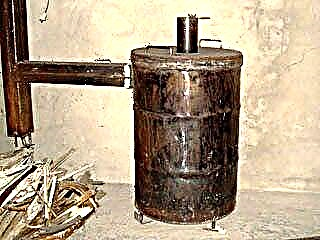
Connecting the stove to the chimney
One rule applies here - put the pipe sections on top of each other in the opposite direction of the smoke movement.
In principle, this can be considered a design ready for operation. But in the process of heating you can notice how much the walls of the furnace are being heated. Therefore, for the convenience of use and ensuring the safety of life, it is better to equip a protective screen.

Brick screen
The protective screen can be folded out of brick. For this, a regular red brick is suitable, which should be laid out at a distance of 10-15 cm from the walls of the furnace. The brick screen, in addition to protection, will increase heat transfer even after the furnace stops burning.
If you plan to install a home-made long-burning furnace in a separate boiler room by connecting a heating system to it, then there will be no sense in installing a protective shield made of brick.
How to operate a homemade long burning stove?
- Remove the cover and remove the device that presses the firewood.
- Fill fuel to the set mark. The critical line is the chimney pipe. Firewood should not be higher than its location.
- The better firewood is compressed and rammed, the greater the burning process will occur in the furnace. Therefore, make sure that the firewood is not large and, laying them in rows, lay chips between them.
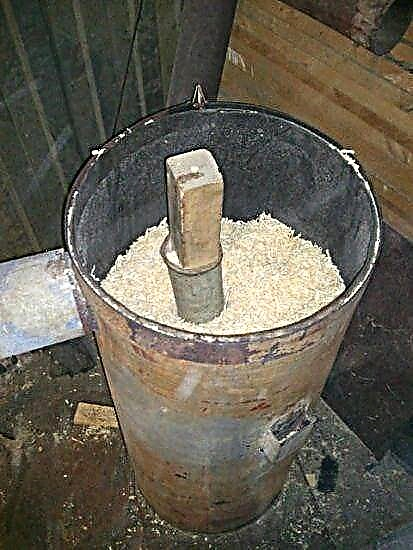
Tamp the firewood well and fill the space with sawdust
The moisture content of firewood should not exceed 20%. Therefore, if you take firewood from a barn or cellar, provide an adequate supply of firewood, which will lie in a dry house for some time. A stylish firewood that can be built with your own hands will allow you to nicely equip such a storage system.
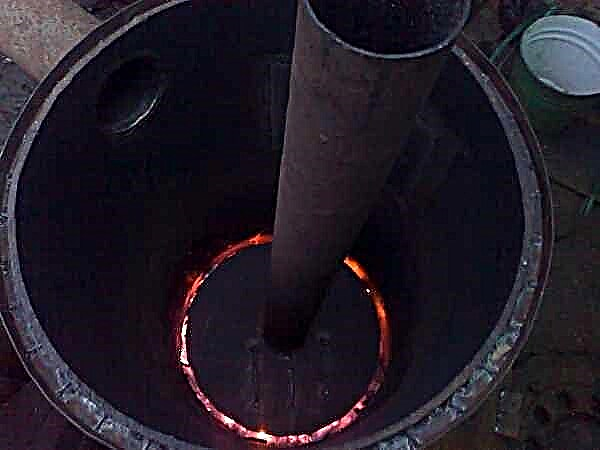
As you can see, it is not so difficult to make a long-burning furnace on your own, which is highly efficient and completely autonomous. It’s difficult to call it home decoration, of course, but for heating purposes with a minimum budget, it will show excellent results.
Do you like the article?
Save so as not to lose!
Wood burning stoves with delivery
In the online store "Ovens-Online" a large selection of stoves-fireplaces is presented at a price of 14 960 rubles. Agree, it's not as expensive as you might think before? All models presented on the site comply with safety regulations and are ideal for a large house or summer house.
If you have any questions, you can fill out the online form on the website or call +7 (343) 226-06-66. Our experts will advise you and help with the selection and purchase of a fireplace stove.
Bavaria's fireplace stoves are very popular among our customers.


